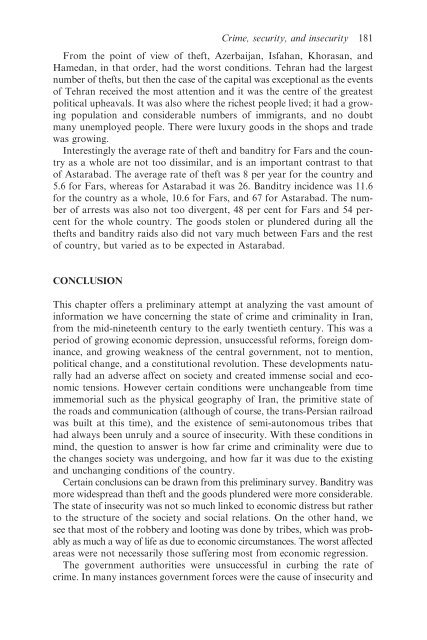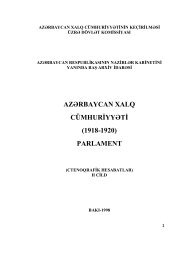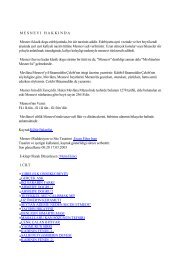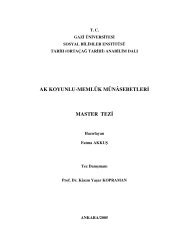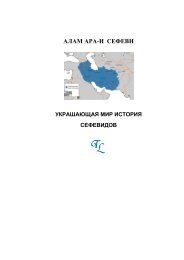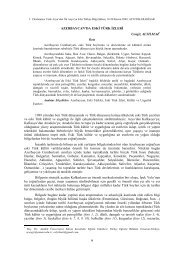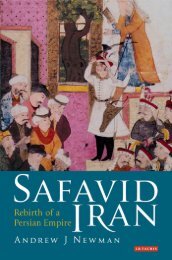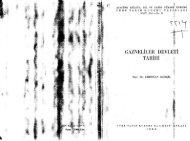Crime, security, <strong>and</strong> <strong>in</strong>security 181From the po<strong>in</strong>t of view of theft, Azerbaijan, Isfahan, Khorasan, <strong>and</strong>Hamedan, <strong>in</strong> that order, had the worst conditions. Tehran had the largestnumber of thefts, but then the case of the capital was exceptional as the eventsof Tehran received the most attention <strong>and</strong> it was the centre of the greatestpolitical upheavals. It was also where the richest people lived; it had a grow<strong>in</strong>gpopulation <strong>and</strong> considerable numbers of immigrants, <strong>and</strong> no doubtmany unemployed people. There were luxury goods <strong>in</strong> the shops <strong>and</strong> tradewas grow<strong>in</strong>g.Interest<strong>in</strong>gly the average rate of theft <strong>and</strong> b<strong>and</strong>itry for Fars <strong>and</strong> the countryas a whole are not too dissimilar, <strong>and</strong> is an important contrast to thatof Astarabad. The average rate of theft was 8 per year for the country <strong>and</strong>5.6 for Fars, whereas for Astarabad it was 26. B<strong>and</strong>itry <strong>in</strong>cidence was 11.6for the country as a whole, 10.6 for Fars, <strong>and</strong> 67 for Astarabad. The numberof arrests was also not too divergent, 48 per cent for Fars <strong>and</strong> 54 percentfor the whole country. The goods stolen or plundered dur<strong>in</strong>g all thethefts <strong>and</strong> b<strong>and</strong>itry raids also did not vary much between Fars <strong>and</strong> the restof country, but varied as to be expected <strong>in</strong> Astarabad.CONCLUSIONThis chapter offers a prelim<strong>in</strong>ary attempt at analyz<strong>in</strong>g the vast amount of<strong>in</strong>formation we have concern<strong>in</strong>g the state of crime <strong>and</strong> crim<strong>in</strong>ality <strong>in</strong> Iran,from the mid-n<strong>in</strong>eteenth century to the early twentieth century. This was aperiod of grow<strong>in</strong>g economic depression, unsuccessful reforms, foreign dom<strong>in</strong>ance,<strong>and</strong> grow<strong>in</strong>g weakness of the central government, not to mention,political change, <strong>and</strong> a constitutional revolution. These developments naturallyhad an adverse affect on society <strong>and</strong> created immense social <strong>and</strong> economictensions. However certa<strong>in</strong> conditions were unchangeable from timeimmemorial such as the physical geography of Iran, the primitive state ofthe roads <strong>and</strong> communication (although of course, the trans-<strong>Persia</strong>n railroadwas built at this time), <strong>and</strong> the existence of semi-autonomous tribes thathad always been unruly <strong>and</strong> a source of <strong>in</strong>security. With these conditions <strong>in</strong>m<strong>in</strong>d, the question to answer is how far crime <strong>and</strong> crim<strong>in</strong>ality were due tothe changes society was undergo<strong>in</strong>g, <strong>and</strong> how far it was due to the exist<strong>in</strong>g<strong>and</strong> unchang<strong>in</strong>g conditions of the country.Certa<strong>in</strong> conclusions can be drawn from this prelim<strong>in</strong>ary survey. B<strong>and</strong>itry wasmore widespread than theft <strong>and</strong> the goods plundered were more considerable.The state of <strong>in</strong>security was not so much l<strong>in</strong>ked to economic distress but ratherto the structure of the society <strong>and</strong> social relations. On the other h<strong>and</strong>, wesee that most of the robbery <strong>and</strong> loot<strong>in</strong>g was done by tribes, which was probablyas much a way of life as due to economic circumstances. The worst affectedareas were not necessarily those suffer<strong>in</strong>g most from economic regression.The government authorities were unsuccessful <strong>in</strong> curb<strong>in</strong>g the rate ofcrime. In many <strong>in</strong>stances government forces were the cause of <strong>in</strong>security <strong>and</strong>
182 Mansoureh Ettehadieh (Nezam-Mafie)created or contributed to situations <strong>in</strong> which raids <strong>and</strong> plunder took place.The situation did not improve with time, but it is not possible to concludewith any precision that the situation grew worse with the grow<strong>in</strong>g economicdepression of the country.Notes1 Michael R. Weisser, Crime <strong>and</strong> Punishment <strong>in</strong> Early Modern Europe (AtlanticHighl<strong>and</strong>s, NJ: Humanities Press, 1979), passim.2 I. Afshar <strong>and</strong> M. R. Daryagasht, eds, Mokhaberat Astarabad, 2 vols (Tehran,1363/1984).3 S. Sirjani, ed., Vaqaye’e Etefaqiyeh (Tehran, 1361).4 C. Issawi, ed., The Economic History of Iran, 1800–1914, (Chicago: University ofChicago Press, 1917), pp. 27–33.5 John Foran, “The Concept of Dependent Development as a Key to the PoliticalEconomy of <strong>Qajar</strong> Iran (1800–1925),” Iranian Studies XXII/2–3 (1989): 19–20.Differences of op<strong>in</strong>ion were likewise expressed by those liv<strong>in</strong>g <strong>in</strong> <strong>Persia</strong> at the time.Comte Julien de Rochechouart, for example, French Consul from 1863–1866(successor to the famous Comte de Gob<strong>in</strong>eau), notes, <strong>in</strong> his Souvenirs d’un Voyageen Perse (Paris, 1867), a record of his travels by road throughout the country,that <strong>in</strong> all of his three years, he never encountered an <strong>in</strong>cident of brig<strong>and</strong>age, orotherwise, “un seul <strong>in</strong>stant d’ennui”.6 See, e.g. Farmanfarmaian, “The politics of concession,” <strong>in</strong> this volume.7 Ibid., pp. 20–22.8 George N. Curzon, <strong>Persia</strong> <strong>and</strong> the <strong>Persia</strong>n Question, 2 vols, 2nd edn (London: FrankCass, 1966), vol. 2, pp. 60–197.9 As this was a contested border area, <strong>and</strong> the Turkomans freely switched loyaltiesfrom one side to another accord<strong>in</strong>g to circumstance, the government authoritieswere engaged as much <strong>in</strong> semi-warfare as <strong>in</strong> the use of force for establish<strong>in</strong>g controlover the area. See for example Cyrus Ghani, Iran <strong>and</strong> the Rise of Reza Shah,From <strong>Qajar</strong> collapse to Pahlavi power (London: I. B. Tauris), pp. 98–99.
- Page 2 and 3:
War and Peace in Qajar PersiaPersia
- Page 4 and 5:
War and Peace inQajar PersiaImplica
- Page 6 and 7:
ContentsList of figuresContributors
- Page 8 and 9:
Figures5.1 Omani enclaves 1305.2 Ar
- Page 10 and 11:
Contributor listMansoureh Ettehadie
- Page 12:
AcknowledgementsThis volume grew ou
- Page 15 and 16:
2 Roxane Farmanfarmaianrepresented
- Page 17 and 18:
4 Roxane Farmanfarmaianchapter in t
- Page 19 and 20:
6 Roxane FarmanfarmaianThus, two si
- Page 21 and 22:
8 Roxane Farmanfarmaiangaining grea
- Page 23 and 24:
10 Roxane Farmanfarmaiantough deals
- Page 25 and 26:
12 Roxane FarmanfarmaianIranian geo
- Page 27 and 28:
14 Peter W. Averyin Shiraz and cont
- Page 29 and 30:
16 Peter W. Averybut the invasion w
- Page 32:
Part IWar
- Page 35 and 36:
22 Manoutchehr M. Eskandari-Qajarth
- Page 37 and 38:
24 Manoutchehr M. Eskandari-Qajarap
- Page 39 and 40:
26 Manoutchehr M. Eskandari-Qajarmi
- Page 41 and 42:
28 Manoutchehr M. Eskandari-Qajarth
- Page 43 and 44:
30 Manoutchehr M. Eskandari-Qajardo
- Page 45 and 46:
32 Manoutchehr M. Eskandari-QajarIn
- Page 47 and 48:
34 Manoutchehr M. Eskandari-Qajarco
- Page 49 and 50:
36 Manoutchehr M. Eskandari-QajarTh
- Page 51 and 52:
38 Manoutchehr M. Eskandari-Qajarth
- Page 53 and 54:
40 Manoutchehr M. Eskandari-Qajarth
- Page 55 and 56:
42 Manoutchehr M. Eskandari-Qajarop
- Page 57 and 58:
44 Manoutchehr M. Eskandari-Qajarbe
- Page 59 and 60:
46 Manoutchehr M. Eskandari-Qajarva
- Page 61 and 62:
48 Stephanie Cronincapacity and res
- Page 63 and 64:
50 Stephanie Croninforces of the es
- Page 65 and 66:
52 Stephanie CroninPART ONE: THE QA
- Page 67 and 68:
54 Stephanie Croninprincipally on h
- Page 69 and 70:
56 Stephanie CroninThe French offic
- Page 71 and 72:
58 Stephanie CroninEuropean alignme
- Page 73 and 74:
60 Stephanie Croninthe authorities
- Page 75 and 76:
62 Stephanie Croninin the revolutio
- Page 77 and 78:
64 Stephanie Croninof power and sta
- Page 79 and 80:
66 Stephanie Croninliving and the m
- Page 81 and 82:
68 Stephanie Croninconsequences for
- Page 83 and 84:
70 Stephanie Croninrevolution was a
- Page 85 and 86:
72 Stephanie CroninNew British miss
- Page 87 and 88:
74 Stephanie CroninBrigade to a Div
- Page 89 and 90:
76 Stephanie Croninwithout the sove
- Page 91 and 92:
78 Stephanie Croninaccounting devic
- Page 93 and 94:
80 Stephanie Croninbut also faced a
- Page 95 and 96:
82 Stephanie Cronindetermined on th
- Page 97 and 98:
84 Stephanie Cronin15 For a discuss
- Page 99 and 100:
86 Stephanie Cronin55 The Anglo-Rus
- Page 101 and 102:
3 The Turko-Persian War1821-1823Win
- Page 103 and 104:
90 Graham WilliamsonThe resultant w
- Page 105 and 106:
92 Graham Williamsonprovincial forc
- Page 107 and 108:
94 Graham WilliamsonThe field armyO
- Page 109 and 110:
96 Graham Williamsonnot hold out mu
- Page 111 and 112:
98 Graham Williamsonoften in arrear
- Page 113 and 114:
100 Graham Williamsonthan any desig
- Page 115 and 116:
102 Graham WilliamsonThere were ove
- Page 117 and 118:
104 Graham Williamsonone should not
- Page 119 and 120:
Table 3.2 Persian regional armies (
- Page 121 and 122:
108 Graham WilliamsonIranian influe
- Page 123 and 124:
4 Social networks andborder conflic
- Page 125 and 126:
112 Vanessa MartinPersian troops on
- Page 127 and 128:
114 Vanessa Martinof comparatively
- Page 129 and 130:
116 Vanessa MartinTHE ROLE OF SOCIA
- Page 131 and 132:
118 Vanessa MartinThe Shah’s negl
- Page 133 and 134:
120 Vanessa Martinborder or any oth
- Page 135 and 136:
122 Vanessa Martin44 No. 38, 2 June
- Page 138 and 139:
5 The consolidation of Iran’sfron
- Page 140 and 141:
Consolidation of Iran’s frontier
- Page 142 and 143:
Consolidation of Iran’s frontier
- Page 144 and 145: Consolidation of Iran’s frontier
- Page 146 and 147: Consolidation of Iran’s frontier
- Page 148 and 149: Consolidation of Iran’s frontier
- Page 150 and 151: Figure 5.2 Arab principalities
- Page 152 and 153: Consolidation of Iran’s frontier
- Page 154 and 155: Consolidation of Iran’s frontier
- Page 156 and 157: Consolidation of Iran’s frontier
- Page 158 and 159: Consolidation of Iran’s frontier
- Page 160 and 161: Consolidation of Iran’s frontier
- Page 162 and 163: 6 Narrowing the frontierMid-ninetee
- Page 164 and 165: Narrowing the frontier 151witnessed
- Page 166 and 167: Figure 6.1 The 1843 borderlands sta
- Page 168 and 169: Narrowing the frontier 155And the S
- Page 170 and 171: Figure 6.2 The 1850 Williams line a
- Page 172 and 173: Narrowing the frontier 159elicited
- Page 174 and 175: Narrowing the frontier 161travellin
- Page 176 and 177: Narrowing the frontier 163be found
- Page 178 and 179: Narrowing the frontier 165A similar
- Page 180 and 181: Narrowing the frontier 167and accep
- Page 182 and 183: Narrowing the frontier 169Perhaps t
- Page 184 and 185: Narrowing the frontier 171By this s
- Page 186 and 187: Narrowing the frontier 17346 For a
- Page 188 and 189: Crime, security, and insecurity 175
- Page 190 and 191: Crime, security, and insecurity 177
- Page 192 and 193: Crime, security, and insecurity 179
- Page 196 and 197: 8 Merchants without bordersTrade, t
- Page 198 and 199: Merchants without frontier 185the m
- Page 200 and 201: Merchants without frontier 187and d
- Page 202 and 203: Merchants without frontier 189photo
- Page 204 and 205: Merchants without frontier 191their
- Page 206 and 207: Merchants without frontier 193In an
- Page 208 and 209: Figure 8.1Seated, first from left:
- Page 210 and 211: Figure 8.3Seated: Hajj Mohammad-Taq
- Page 212 and 213: Figure 8.5 Taken in Hajj Hasan Jour
- Page 214 and 215: Merchants without frontier 201Figur
- Page 216 and 217: Merchants without frontier 203Studi
- Page 218 and 219: Merchants without frontier 20516 Me
- Page 220 and 221: Merchants without frontier 207and t
- Page 222 and 223: Merchants without frontier 209or pu
- Page 224 and 225: Merchants without frontier 211It ca
- Page 226 and 227: 9 The politics of concessionReasses
- Page 228 and 229: The politics of concession 215gradu
- Page 230 and 231: The politics of concession 217Shah,
- Page 232 and 233: The politics of concession 219assig
- Page 234 and 235: The politics of concession 221compa
- Page 236 and 237: The politics of concession 223gross
- Page 238 and 239: The politics of concession 225the B
- Page 240 and 241: The politics of concession 227as th
- Page 242 and 243: IndexAbbas Mirza, Crown Prince 6, 1
- Page 244 and 245:
Index 231Gulf Arabs 127-9Gwadar 136
- Page 246 and 247:
Index 233policy in Persian Gulf 131


